Welcome to the intriguing world of Mousebirds, where avian wonders await your discovery. From their distinct traits to their captivating behaviors, Mousebirds of the family Coliidae have long captured the curiosity of bird enthusiasts. Have you ever wondered what makes these unique creatures stand out in the avian kingdom?
In this article, we will delve into the fascinating world of Mousebirds, exploring their vibrant colors, interesting characteristics, and the diverse species that encompass this avian family. Join us as we uncover their secrets and shed light on their extraordinary adaptations.
Main points to note:
- Mousebirds, part of the Coliidae family, possess unique traits that set them apart from other avian species.
- The genus Colius includes species like the red-backed mousebird, speckled mousebird, white-backed mousebird, and white-headed mousebird.
- The genus Urocolius is home to the blue-naped mousebird and the red-faced mousebird, each with its own distinctive features.
- Mousebirds exhibit fascinating behaviors and possess adaptations that enable them to thrive in their specific habitats.
- These avian wonders can be found in various habitats across Africa, showcasing their adaptability and fascinating distribution patterns.
Genus Colius
Mousebirds of the genus Colius are a fascinating group of avian wonders known for their vibrant colors and interesting characteristics. Within this genus, you’ll find several distinct species, each with its own unique traits and behaviors.
Red-backed Mousebird (Colius castanotus)
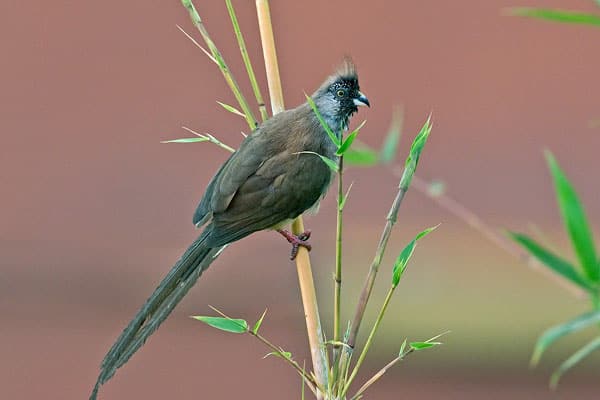
The red-backed mousebird is known for its striking red plumage on its back, which contrasts beautifully with its grayish-brown body. These active birds are highly social and often seen in small flocks, foraging for berries, fruits, and seeds.
Speckled Mousebird (Colius striatus)
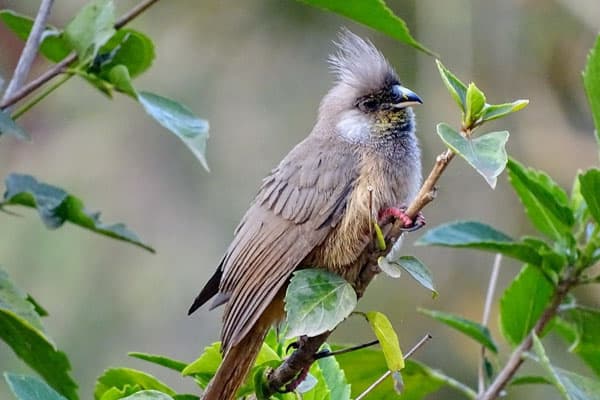
The speckled mousebird features a combination of speckled black and white plumage, giving it a captivating appearance. These agile climbers are commonly found in woodlands and savannahs, feeding on various fruits, buds, and insects.
White-backed Mousebird (Colius colius)
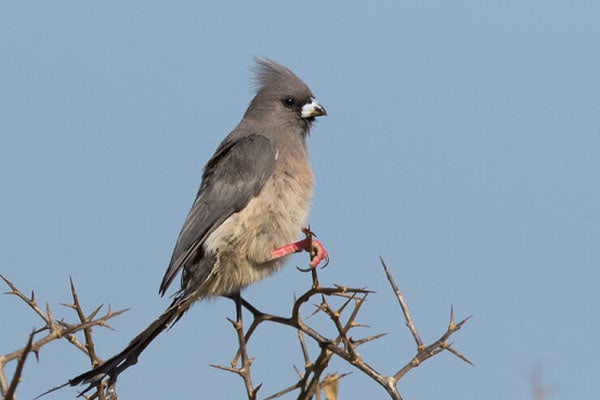
The white-backed mousebird stands out with its white underparts and distinctive white feathers on its back. Known for their acrobatic flight patterns, these birds can be found in arid regions and feed on a diet primarily consisting of berries, seeds, and flowers.
White-headed Mousebird (Colius leucocephalus)
The white-headed mousebird showcases a unique white head and neck, making it especially striking. These birds prefer dense vegetation, such as thickets and shrubs, where they search for their preferred diet of fruits, flowers, and leaves.
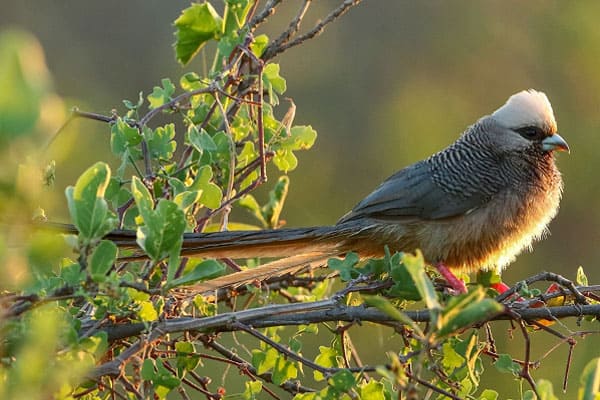
Each species within the Colius genus brings its own personality and beauty to the world of mousebirds, adding to the diversity and wonder of these remarkable avian creatures.
| Species | Common Name | Distinctive Features | Habitat |
|---|---|---|---|
| Colius castanotus | Red-backed Mousebird | Red plumage on the back | Woodlands, savannas |
| Colius striatus | Speckled Mousebird | Speckled black and white plumage | Woodlands, savannahs |
| Colius colius | White-backed Mousebird | White feathers on the back | Arid regions |
| Colius leucocephalus | White-headed Mousebird | White head and neck | Thickets, Shrubs |
Genus Urocolius
Continuing our exploration of Mousebirds, we now turn our attention to the fascinating genus Urocolius, which includes two distinct species: the blue-naped mousebird (Urocolius macrourus) and the red-faced mousebird (Urocolius indicus).
These remarkable birds possess their own unique features and behaviors that distinguish them from their Colius counterparts. Let’s delve deeper into the characteristics of each species:
Blue-Naped Mousebird (Urocolius macrourus)

The blue-naped mousebird is a striking bird known for its vibrant plumage and distinct blue nape. Its body is predominantly olive green, while its wings are adorned with eye-catching patches of bright yellow. This species is found in the dry woodlands and scrublands of eastern and southern Africa.
Red-Faced Mousebird (Urocolius indicus)

The red-faced mousebird stands out with its crimson facial patches, giving it a unique and captivating appearance. Its body is predominantly grayish-brown, complemented by a long, slender tail. This species inhabits the dense forests and thickets of central and western Africa.
“The blue-naped mousebird and red-faced mousebird exemplify the incredible diversity within the Urocolius genus, showcasing nature’s endless creativity.”
These Urocolius species exhibit fascinating behaviors, such as their ability to move with agility through dense foliage and their tendency to move in small family groups. Both species primarily feed on fruits, seeds, and insects, using their specialized bills to extract nourishment from various food sources.
Now that we have explored the Genus Urocolius, we can truly appreciate the extraordinary diversity and remarkable characteristics of Mousebirds, from the Colius to the Urocolius species. In the next section, we will uncover the unique traits and behaviors that make Mousebirds such exceptional avian wonders.
| Species | Distinct Features | Habitat | Distribution |
|---|---|---|---|
| Blue-Naped Mousebird | Blue nape, olive green body, yellow wing patches | Dry woodlands and scrublands | Eastern and southern Africa |
| Red-Faced Mousebird | Red facial patches, grayish-brown body, long tail | Dense forests and thickets | Central and western Africa |
Check Our Previous Articles:
| 6 Small Birds with Long Beaks (With Photos) |
| 7 Owls in Arkansas (With Photos) |
| Species to Know About Cranes in Michigan |
Unique Traits and Behaviors
Mousebirds, belonging to the family Coliidae, are truly fascinating creatures with a range of unique traits and behaviors that set them apart from other avian species.
One of their most distinctive features is their zygodactyl feet, which means that they have two toes pointing forward and two toes pointing backward. This specialized foot structure allows them to have a strong grip while perching on branches, making them excellent climbers.
Mousebirds also exhibit an arboreal lifestyle, primarily residing and foraging in trees. Their elongated tails and sharp claws are adaptations that aid them in maintaining balance and maneuvering through the dense foliage.
Another interesting behavior displayed by these avian wonders is their social nature. Mousebirds are highly sociable birds that live in small groups, known as colonies or flocks. Within these groups, they engage in activities such as grooming each other, foraging together, and even building nests communally.
“Mousebirds truly embody the beauty of nature with their unique adaptations and captivating behaviors.”
In addition to their physical traits and social behaviors, Mousebirds also possess an incredible ability to swallow fruit whole. These birds have a specialized digestive system that allows them to consume large fruits, digesting the pulp and extracting the necessary nutrients.
Unique Traits:
- Zygodactyl feet
- Arboreal lifestyle
- Specialized digestion for swallowing whole fruits
Mousebirds’ adaptation of swallowing whole fruits contributes to seed dispersal, as undigested seeds from their diet are later eliminated in their droppings, promoting plant diversity and regeneration in their habitats.
These unique traits and behaviors collectively make Mousebirds an intriguing and exceptional group of birds, deserving further exploration and appreciation.
| Unique Traits | Behaviors |
|---|---|
| Zygodactyl feet | Allows strong grip while climbing and perching |
| Arboreal lifestyle | Reside and forage in trees |
| Specialized digestion for swallowing whole fruits | Facilitates seed dispersal |
Habitat and Distribution
Mousebirds are versatile birds that inhabit various habitats across Africa. Their distribution patterns are influenced by a combination of factors, including food availability and vegetation types. Let’s explore their habitat preferences and learn more about their distribution across the continent.
Habitat Preferences
Mousebirds have the ability to adapt to different environments, allowing them to thrive in a range of habitats. They are commonly found in:
- Woodlands: Mousebirds are often spotted in woodland areas, where trees provide them with ample perching spots and potential nesting sites.
- Savannas: These open grassy areas with scattered trees and shrubs are another favored habitat for Mousebirds.
- Acacia Groves: Mousebirds are known to inhabit acacia groves, where they take advantage of the abundant food resources available in these tree-dominated areas.
In each of these habitats, Mousebirds utilize their zygodactyl feet to effortlessly move among branches and forage for food.
Distribution across Africa
Mousebirds are primarily found in sub-Saharan Africa, with a distribution range that spans from Angola and Tanzania in the east, to Namibia and South Africa in the south. They can also be observed in countries such as Kenya, Uganda, Zambia, and Zimbabwe.
While Mousebirds can be found throughout this extensive region, their abundance and population density may vary within specific areas due to local environmental conditions and habitat suitability.
Now that we’ve explored the diverse habitats and distribution of Mousebirds, let’s delve deeper into their unique traits and behaviors in the next section.
| Types of Habitat | Examples |
|---|---|
| Woodlands | Deciduous woodlands, rainforests |
| Savannas | Grassy savannas, tree-studded savannas |
| Acacia groves | Thorny acacia groves, open acacia woodlands |
Conclusion
After immersing yourself in the captivating world of Mousebirds, you have gained a deeper understanding of their unique traits, behaviors, and diversity within the Coliidae family. These avian wonders continue to stand out as an intriguing group of birds, deserving further appreciation and study.

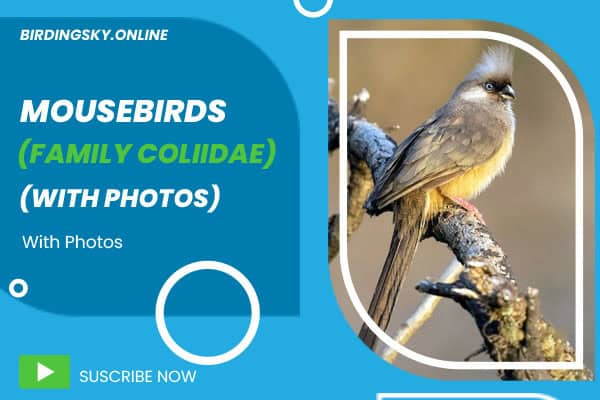
Add comment